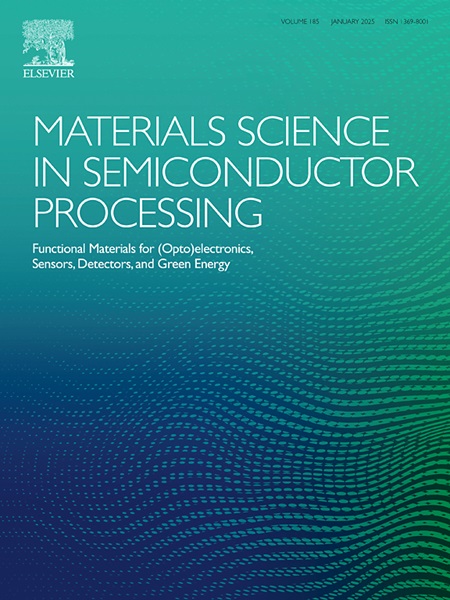Tuning charge dynamics in MIL-88A(Fe) via decoration by boron carbon nitride quantum dots for superior photocatalytic elimination performance
IF 4.6
3区 工程技术
Q2 ENGINEERING, ELECTRICAL & ELECTRONIC
引用次数: 0
Abstract
The development of efficient and sustainable strategies for the removal of pharmaceutical pollutants from aqueous environments has become a critical challenge. Boron carbon nitride quantum dots (BCNQDs) have emerged as highly promising materials in photocatalysis, offering substantial performance advantages. In this study, BCNQDs were successfully integrated onto the MIL-88A(Fe) framework for the first time via a simple impregnation technique. Characterization analyses confirmed that the crystalline integrity and surface functionalities of MIL-88A(Fe) were preserved following BCNQDs decoration. HRTEM images revealed spherical BCNQDs uniformly distributed over the hexagonal rod-like MIL-88A structure. Photoluminescence (PL) and photocurrent analyses demonstrated that the integration of BCNQDs effectively suppressed electron–hole recombination. Moreover, the photocatalytic performance was significantly enhanced, with tetracycline (TC) removal efficiency increasing from 45.09 % for pristine MIL-88A to 95.19 % in the optimized MIL-88A(Fe)@BCNQDs catalyst, alongside a sixfold increase in reaction rate. This improvement was attributed to synergistic effects including enhanced charge separation, extended light absorption, favorable band structure modulation, and improved pollutant–catalyst interactions. The hybrid photocatalyst maintained high degradation efficiencies in various water matrices, achieving 84.1 % and 71.2 % removal in tap water and seawater, respectively. Radical scavenging experiments revealed a hole-dominated photocatalytic pathway, with BCNQDs functioning as efficient electron traps, thereby prolonging hole lifetimes and enabling effective oxidation under visible light. Additionally, the MIL-88A(Fe)@BCNQDs catalyst exhibited excellent reusability, retaining over 70 % efficiency after eight consecutive cycles. Overall, this study pioneers the integration of BCNQDs into a MOF-based photocatalyst, unveiling their untapped potential as next-generation, eco-friendly co-catalysts. The findings not only modulate charge carrier dynamics but also establish a new benchmark for sustainable antibiotic degradation under visible light.

硼碳氮化量子点修饰MIL-88A(Fe)的电荷动力学,获得优异的光催化消除性能
从水环境中去除药物污染物的有效和可持续战略的发展已成为一个关键的挑战。氮化硼碳量子点(BCNQDs)在光催化领域具有广泛的应用前景。在这项研究中,BCNQDs首次通过一种简单的浸渍技术成功地集成到MIL-88A(Fe)框架上。表征分析证实,BCNQDs修饰后MIL-88A(Fe)的晶体完整性和表面功能得以保留。HRTEM图像显示球形BCNQDs均匀分布在六边形棒状MIL-88A结构上。光致发光(PL)和光电流分析表明,BCNQDs的集成有效地抑制了电子-空穴复合。此外,优化后的MIL-88A(Fe)@BCNQDs催化剂的光催化性能显著提高,四环素(TC)的去除率从原始MIL-88A的45.09%提高到95.19%,反应速率提高6倍。这种改善归因于协同效应,包括增强的电荷分离,扩展的光吸收,有利的能带结构调制以及改善的污染物-催化剂相互作用。杂化光催化剂在各种水基质中保持了较高的降解效率,在自来水和海水中的去除率分别达到84.1%和71.2%。自由基清除实验揭示了一种以空穴为主的光催化途径,BCNQDs作为有效的电子陷阱,从而延长了空穴寿命,并在可见光下实现了有效的氧化。此外,MIL-88A(Fe)@BCNQDs催化剂表现出优异的可重复使用性,在连续8次循环后保持超过70%的效率。总的来说,这项研究率先将BCNQDs整合到基于mof的光催化剂中,揭示了它们作为下一代环保共催化剂的未开发潜力。这一发现不仅调节了载流子动力学,而且为抗生素在可见光下的可持续降解建立了新的基准。
本文章由计算机程序翻译,如有差异,请以英文原文为准。
求助全文
约1分钟内获得全文
求助全文
来源期刊

Materials Science in Semiconductor Processing
工程技术-材料科学:综合
CiteScore
8.00
自引率
4.90%
发文量
780
审稿时长
42 days
期刊介绍:
Materials Science in Semiconductor Processing provides a unique forum for the discussion of novel processing, applications and theoretical studies of functional materials and devices for (opto)electronics, sensors, detectors, biotechnology and green energy.
Each issue will aim to provide a snapshot of current insights, new achievements, breakthroughs and future trends in such diverse fields as microelectronics, energy conversion and storage, communications, biotechnology, (photo)catalysis, nano- and thin-film technology, hybrid and composite materials, chemical processing, vapor-phase deposition, device fabrication, and modelling, which are the backbone of advanced semiconductor processing and applications.
Coverage will include: advanced lithography for submicron devices; etching and related topics; ion implantation; damage evolution and related issues; plasma and thermal CVD; rapid thermal processing; advanced metallization and interconnect schemes; thin dielectric layers, oxidation; sol-gel processing; chemical bath and (electro)chemical deposition; compound semiconductor processing; new non-oxide materials and their applications; (macro)molecular and hybrid materials; molecular dynamics, ab-initio methods, Monte Carlo, etc.; new materials and processes for discrete and integrated circuits; magnetic materials and spintronics; heterostructures and quantum devices; engineering of the electrical and optical properties of semiconductors; crystal growth mechanisms; reliability, defect density, intrinsic impurities and defects.
 求助内容:
求助内容: 应助结果提醒方式:
应助结果提醒方式:


